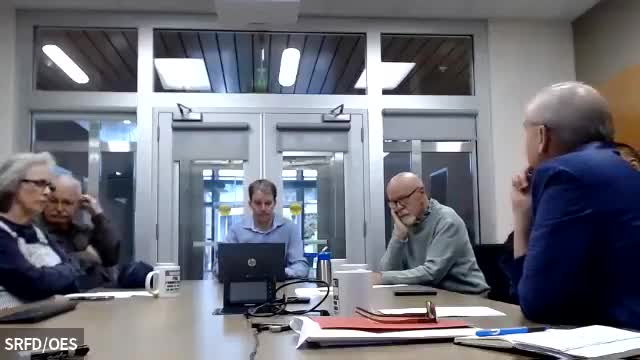San Rafael commissioners hear property insurance market update amid wildfire volatility
October 14, 2025 | San Rafael, Marin County, California
This article was created by AI summarizing key points discussed. AI makes mistakes, so for full details and context, please refer to the video of the full meeting. Please report any errors so we can fix them. Report an error »

Melissa Stifle, area senior vice president for property insurance at Risk Placement Services (RPS), told the San Rafael Fire Commission that commercial property insurance softened in 2025 but remains vulnerable to large weather losses. "So far in 2025, we have seen rate decreases," Stifle said, adding that declines have in some cases exceeded 20 percent and that terms and conditions had improved.
The change follows a period of sharp rate increases from 2020 to 2023, Stifle said, driven by significant catastrophe losses and constrained capital. "You saw pricing get very expensive," she said, and insurers cut capacity, sometimes shrinking limits from $10 million to $2.5 million on individual placements.
City officials said the presentation is directly relevant to San Rafael's property portfolio and budgeting. Commissioners and staff discussed how underwriting models and the fire department's protection class influence insurer offers. Stifle described the use of analytics and catastrophe models—typically RMS or AIR—to estimate probable maximum loss for a municipality and said brokers use those modeled loss figures to help decide how much coverage to purchase.
Commissioners noted that the city has roughly $2 billion of property exposure and that, depending on modeling and mitigation, insurers may recommend much lower purchased limits. "So that's what they'll buy to," a commissioner said, describing how modeling can produce a lower probable maximum loss and therefore a smaller insured limit. Stifle confirmed brokers can compare historical and current-model outputs to show how mitigation and improved fire protection have changed risk profiles.
Stifle urged local mitigation measures that underwriters frequently factor into pricing and capacity decisions, including controlled clearance and roof/gutter debris removal, sealing gaps around structures, removing combustible vegetation close to buildings, ensuring reliable water supply and alternative water sources, and addressing ingress/egress issues. "Focus on running clearance, removing debris from the roofs, the rain gutters ... Be aware of any ingress issues you have," she said.
She also warned that large, nonlocal catastrophes affect availability and price in California because insurance capital is shared across perils and states. Stifle cited recent large-loss events and said the commercial market is set up to absorb roughly $120 billion of losses; recent storms and wildfires have consumed much of that capacity.
Why this matters: city officials use modeled loss estimates and insurer feedback when deciding how much property insurance to buy and which mitigation investments to prioritize. Commissioners asked about demonstrating the budgetary value of mitigation—whether spending on vegetation management or Firewise programs translates to premium savings—and were told insurers and brokers can model that effect.
Commissioners thanked Stifle for the briefing and discussed next steps, including sharing modeling outputs with the city's finance staff and continuing to prioritize fire protection and home-hardening outreach.
The change follows a period of sharp rate increases from 2020 to 2023, Stifle said, driven by significant catastrophe losses and constrained capital. "You saw pricing get very expensive," she said, and insurers cut capacity, sometimes shrinking limits from $10 million to $2.5 million on individual placements.
City officials said the presentation is directly relevant to San Rafael's property portfolio and budgeting. Commissioners and staff discussed how underwriting models and the fire department's protection class influence insurer offers. Stifle described the use of analytics and catastrophe models—typically RMS or AIR—to estimate probable maximum loss for a municipality and said brokers use those modeled loss figures to help decide how much coverage to purchase.
Commissioners noted that the city has roughly $2 billion of property exposure and that, depending on modeling and mitigation, insurers may recommend much lower purchased limits. "So that's what they'll buy to," a commissioner said, describing how modeling can produce a lower probable maximum loss and therefore a smaller insured limit. Stifle confirmed brokers can compare historical and current-model outputs to show how mitigation and improved fire protection have changed risk profiles.
Stifle urged local mitigation measures that underwriters frequently factor into pricing and capacity decisions, including controlled clearance and roof/gutter debris removal, sealing gaps around structures, removing combustible vegetation close to buildings, ensuring reliable water supply and alternative water sources, and addressing ingress/egress issues. "Focus on running clearance, removing debris from the roofs, the rain gutters ... Be aware of any ingress issues you have," she said.
She also warned that large, nonlocal catastrophes affect availability and price in California because insurance capital is shared across perils and states. Stifle cited recent large-loss events and said the commercial market is set up to absorb roughly $120 billion of losses; recent storms and wildfires have consumed much of that capacity.
Why this matters: city officials use modeled loss estimates and insurer feedback when deciding how much property insurance to buy and which mitigation investments to prioritize. Commissioners asked about demonstrating the budgetary value of mitigation—whether spending on vegetation management or Firewise programs translates to premium savings—and were told insurers and brokers can model that effect.
Commissioners thanked Stifle for the briefing and discussed next steps, including sharing modeling outputs with the city's finance staff and continuing to prioritize fire protection and home-hardening outreach.
View full meeting
This article is based on a recent meeting—watch the full video and explore the complete transcript for deeper insights into the discussion.
View full meeting
